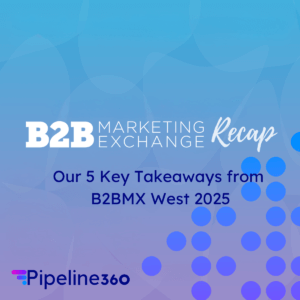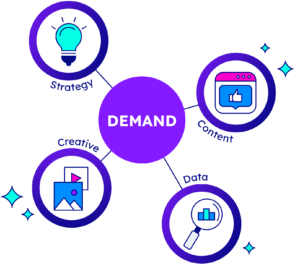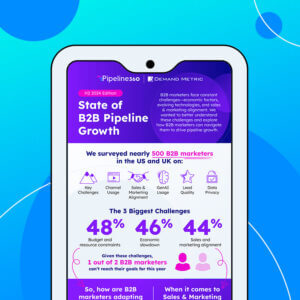Budget, headcount and the increased drive of GTM efficiency were — predictably — cited as the biggest obstacle for marketing teams, according to Pipeline360’s State of Pipeline Growth H2 2024 report with 48% of respondents identifying the troubling triad that always travels together as holding them back.
The slowing economy came next, at 46%, adding to the sense that uncontrollable monetary matters are ruining ROI, and, perhaps, there is little teams can do about it other than make cuts.
The third biggest roadblock revealed in the report, rather than being insurmountable, might just be the key to overcoming, or at least easing the impact of, the other problems.
44% of those surveyed noted it, many teams have a cost-free opportunity to unlock improved performance.
The issue is sales and marketing alignment.
A myriad of technological advances in the industry have allowed teams to keep pace in a forever-changing marketplace, but unfortunately, the most basic of tactics — teamwork — still presents a problem. However, a culture change may well be the tactic that changes fortunes for teams and ensures goals are met.
Buyers have become increasingly disconnected from the process sales and marketing teams have traditionally laid out for them, so the two must align internally to rebuild the pathways to purchase.
It can’t be done in isolation. Buyers are too savvy now and expect a seamless experience of little influence, but maximum value.
Align On Goals and Meet Targets Together
Pipeline360’s report found almost half, 47%, of respondents, were struggling to meet their goals. Yet, 73% of those who embraced sales-marketing alignment did.
Teams that work together win together.
That’s probably why 75% of respondents are already embracing alignment —34% completely and 41% mostly.
Many businesses are missing out, despite this being a controllable, cost-free optimization that could significantly enhance performance.
But a good number aren’t yet aligning. And this, unfortunately, is also not that surprising.
Alignment: Stop, Collaborate and Listen!
Despite the benefits, alignment is something many sales and marketing teams have struggled with, and resisted, for a long time. But it isn’t just about butting heads. Management sometimes even plays a part.
Sales and marketing have traditionally operated with different mindsets with very different work cultures and incentives: sales are results-driven and have a short-term revenue focus, while marketing plays a longer game, building awareness while simultaneously ensuring predictable pipeline.
This siloed approach adds another barrier to new business, as it creates another layer of disconnection.
Teams must engage so customers do.
Misaligned goals and KPIs exacerbate the problem, as both teams just focus on their targets — false finish lines — which fuels a blame game when things don’t go to plan.
But it isn’t simply down to culture and personality, budget is also to blame, and technology can keep teams apart. Often a lack of unified technology and data sharing makes teamwork difficult to achieve, and even harder to measure.
And, for already stretched teams, it’s just another problem they might not think they have the time to fix.
Teamwork — More Than Working Together
The teamwork approach spread beyond process and goal setting, with 15% of those surveyed reporting completely overlapping KPIs and objectives — meaning they were aligned to chase, convert and share the spoils. Almost half, 47%, classified the crossover as ‘significant’.
For 22%, the overlap was partial, so, in total, 84% are working together to some degree. For 9%, the overlap was negligible. So, again, for a reasonable cohort, there’s an easy lever to pull straight away to boost performance.
By aligning around shared goals and KPIs, sales and marketing can work more strategically, creating a collaborative culture and feedback loop that ultimately drives greater revenue growth and customer satisfaction.
Alignment takes the bumps out of the buyer’s journey, as both teams are working to ensure a smooth journey, with singular messaging and positioning, from the first interaction to the last. This consistency doesn’t just grease the sales funnel, it builds trust and can shorten sales cycles.
Working towards the same KPIs helps both teams better understand the buyer’s journey and allocate resources more effectively: marketing can focus on leads more likely to convert and sales on high-potential prospects. And operating from the same data and dashboards ensures teams are unified on what’s driving performance, what’s working, what’s not, and what to try next.
As well as making teams work better, alignment also fosters accountability and reduces finger-pointing and lone-wolf tactics. It ensures both teams are equally motivated, as they will also be equally responsible for successes and failures.
Alignment: You Can’t Argue with the Results
When weighed against goal attainment, the alignment of sales and marketing efforts appears to be paying off.
Of those who reported complete or significant overlap, 67%, said they were meeting their goals to a great or very great extent, whereas only 36% of those who said there was little, or no alignment were achieving theirs.
With 20% of respondents reporting average sales cycles lasting a year or more, this disconnect is likely causing long-term problems.
Lead Quality Is Better When Teams Unite on Process
When it came to leads, having an agreed-upon process in place boosted how teams felt about those prospects: 79% of study participants recorded being satisfied or very satisfied with lead quality.
Without process alignment, 41% enjoyed the same level of contentment. The good news is 75% of those surveyed indicated that agreements were in place. When teams aren’t aligned, they also lose track of performance.
So, let’s recap.
Teams that aren’t aligned are less likely to meet goals, less satisfied with the quality of their leads, and less likely to pay attention to the results that they’re less likely to achieve.
Easy fix. Easy win.
While revenue was unsurprisingly the most-tracked metric at 62%, when process agreements weren’t in place the percentage of teams tracking it fell significantly.
For teams working together, 66% kept an eye on the money, while it was only part of the process for 47% who were working separately.
Budgets, headcounts, resources and the economy are headwinds B2B marketers will always face, and there’s little they can do about it, other than, as they’re often asked, ‘do more with less’.
But teamwork — aligning with sales on everything from process to goals — is easy. And at zero cost, it has to be a tactic that every team makes a priority.
It’s an adjustment, but it might just change everything.


















